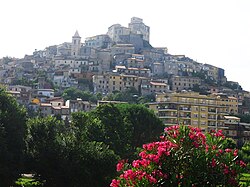History
The town had its origins as an ancient Volscian citadel that surrendered to the Romans in 330 BC (424 Ab Urbe Condita). [3] Its name in ancient times was Fabrateria Vetus.
According to tradition, the name was changed into the current one in the early Middle Ages. This was done in honor of one Petronius Ceccanus – father of Pope Honorius I. Conquered by the Lombards at the time of King Aistulf (c. 750), later it became an important fortress of the Papal territories. In 1218, a monk from nearby Fossanova Abbey compiled the Annals of Ceccano . From 900 to 1450, it was ruled by the local Counts of Ceccano – most likely of German origin; later their territories were assigned to Rodrigo Borgia by Pope Alexander VI and then to the Colonna family.
From 3 November 1943 and 31 May 1944, during World War II, the town suffered 38 air attacks from Allied forces despite having no strategic importance. During one of these air attacks, the Church of Santa Maria a Fiume – a national monument, was destroyed. Canadian Army war artist Charles Comfort painted the town as it appeared during the Second World War.
This page is based on this
Wikipedia article Text is available under the
CC BY-SA 4.0 license; additional terms may apply.
Images, videos and audio are available under their respective licenses.



